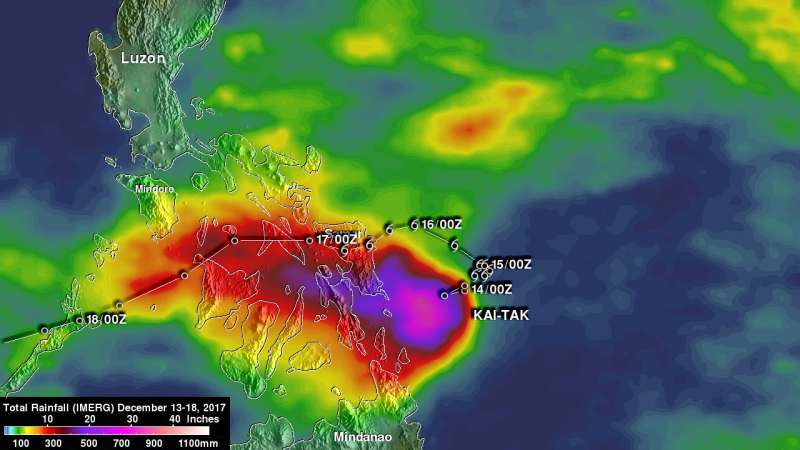NASA calculated Philippines rainfall from Tropical Storm Kai-Tak

Tropical Storm Kai-Tak moved through the central and southern Philippines over several days and weakened to a remnant low pressure area in the South China Sea. As it moved over the country, NASA found that the storm generated heavy amounts of rainfall.
Tropical storm Kai-Tak was nearly stationary at times as it drenched the Philippines from Dec. 14 through 18. The storm caused major flooding and landslides. Many homes, roads and bridges were reported destroyed by landslides.
A rainfall accumulation analysis of Tropical Cyclone Kai-Tak was derived from NASA's Integrated Multi-satellitE Retrievals data (IMERG) for the period from December 13 to 18, 2017.
IMERG data were used to calculate estimates of precipitation from a combination of space-borne passive microwave sensors, including the GMI microwave sensor onboard the Global Precipitation Measurement mission or GPM satellite, and geostationary satellite infrared data.
These IMERG rainfall totals showed that very heavy rainfall occurred along the tropical storm's track from the Philippine Sea through the central Philippines where estimated totals were over 512 mm (20.2 inches)
On Dec. 15, the GPM core observatory satellite flew over tropical storm Kai-Tak as it was crossing into the eastern Philippines on December 15, 2017 at 6:02 p.m. EST (2302 UTC). GPM is a joint mission between NASA and the Japan Aerospace Exploration Agency, JAXA.
At that time, GPM's Microwave Imager (GMI) and Dual-Frequency Precipitation Radar (DPR) instruments received data that showed the locations of very heavy rainfall inside the tropical storm. GPM's radar (DPR Ku Band) observed that the maximum rainfall rate at that time was greater than 193 mm (7.59 inches) per hour in storms located just east of the central Philippines. GPM's radar (DPR Ku band) data revealed some storm top heights over the Philippine Sea were reaching altitudes above 17.9 km (11.1 miles).
Kai-Tak weakened while moving into the South China Sea southwest of the Philippines and the Joint Typhoon Warning Center issued their final advisory on the system on Monday, Dec. 18.
On Dec. 19, Kai-Tak's remnants appeared as an amorphous area of clouds in the South China Sea.
Provided by NASA's Goddard Space Flight Center



















